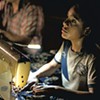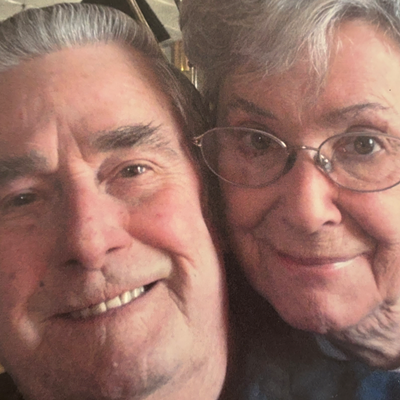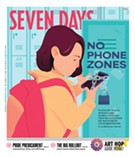Friday, June 7, 2013
Film / Movies Movies You Missed & More: Side by Side
Posted
By Margot Harrison
on Fri, Jun 7, 2013 at 4:31 PM
This week in movies you missed: The movies you see in theaters no longer "flicker." Your favorite summer drive-in is running a fundraiser to stay open. Your 18-year-old nephew is posting videos to YouTube and Vimeo and calling himself a "filmmaker."
What do all these phenomena have in common? They're symptoms of the seismic shift from "film" film to digital film. This documentary from Christopher Kenneally explains.
What You Missed
How will the film industry change when "films" are no longer shot on film, edited on film, screened on film or preserved on film? How close are we to that point? How did we get here? Is it the dawning of a glorious new age, or a dark moment in the history of a century-old art form?
Kenneally, making his feature directorial debut with this 2012 doc, doesn't answer that last question. Nor does its narrator, Keanu Reeves. Instead, they interview a slew of filmmakers, including some of Hollywood's most prominent directors: Martin Scorsese (pictured), James Cameron, the Wachowskis, David Fincher, Christopher Nolan, Steven Soderbergh, George Lucas and more.
Everybody has a passionate opinion about the rise of digital filmmaking, from Soderbergh, who loves it, to Nolan, who hates it. Using clips from famous films and behind-the-scenes footage, Kenneally illustrates their arguments for the layman.
He also retraces the history of the digital camera, the rise of digital editing, visual effects and color timing, and the ongoing changeover to digital theater exhibition.
By the end, it's clear that film vs. digital is not just a techie debate. The seemingly imminent death of traditional filmmaking means something to everyone who loves watching or dreams of making movies. And, as digital manipulation becomes standard, it could be changing the way people view all reproduced images.
Why You Missed It
Widest release: nine theaters. Now streaming on Netflix Instant as well as available on DVD, etc.
Should You Keep Missing It?
In the past year, I've written about the endangered status of drive-ins in a digital world and about the conversion of the last 35-millimeter theaters in Burlington. Now, here's a confession: When I go to a movie, I cannot instantly tell whether it was shot on film or digitally. Nor can I tell — without using external clues such as the absence of "cigarette burns" and flickering in the projection booth — whether it's being projected digitally.
My filmmaker and hard-core cinephile friends do instantly see the difference — and care about it. The mass of moviegoers, I would guess, do not. Like me, they're more focused on the story, the characters, the awesome stunts and the explosions than the technology used to produce them.
The one thing everybody does notice is glaringly good or bad computer-generated imagery — like the jungles of Avatar or that creepy baby in The Twilight Saga: Breaking Dawn.
But did you know that Oh Brother, Where Art Thou was manipulated in postproduction so cinematographer Roger Deakins could make the trees the color he wanted? Or that Fincher needed a specially built digital Red camera to film from the prow of a sculling boat in The Social Network? Or that those scenes of Cillian Murphy wandering around postapocalyptic London in 28 Days Later could not have been shot on film? (By putting small digital cameras all over, director Danny Boyle could capture the scene in the few minutes he could afford to clear the street of cars.)
This is fascinating stuff. Kenneally's interviewees tell us how digital tech has changed not just the look of film, but the whole experience and culture of filmmaking. We learn how that technology advanced from the grainy Sony SD cameras of the '90s to current state-of-the-art models such as the Red Epic and Arri Alexa — and how cheaper DSLR cameras, created for photojournalists, have revolutionized indie filmmaking. (Lena Dunham says she owes her career to one.)
On the flip side, we get images vividly illustrating film purists' longstanding objections to digital: for instance, its lack of dynamic range.
Then there's the still-unsolved question of how all this digital data are going to be stored for the future. Properly preserved film can last for centuries. Hard drives, not so much. Are our digital spectacles doomed to disappear?
Keanu's surfer-dude narration is a little hard to take at first. But he projects an earnest and believable interest in the subject — as well he should, since it's his livelihood.
I like how Kenneally doesn't neglect the cinematographers and editors — who are, if anything, even more opinionated than the directors — and he shows us what they're talking about every step of the way. If somebody mentions cut-and-tape editing, for instance, we see how it's done.
For some, all this will be old news. For me, it was eye opening.
Verdict: Hollywood directors publicizing their latest movie or giving an Oscar acceptance speech = yawn. Hollywood directors debating a controversial aspect of their craft = well worth checking out.
In Theaters This Week
Greta Gerwig plays what could become an archetypal Gen Y role in Frances Ha, the latest from Noah Baumbach, only at the Savoy Theater.
Vince Vaughn and Owen Wilson are Gen Xers stumped by technology, 'cause they're old, in The Internship. (Whatever happened to all those brilliant hacker kids from '80s movies? )
People get killed, duh, when the government declares a 12-hour crime-spree free-for-all in The Purge.
On Video This Week
Warm Bodies. Identity Thief. Escape From Planet Earth. A Good Day to Die Hard.
And season 5.1 of "Breaking Bad" — which, by the way, is mostly shot on 35-millimeter film and makes me want to visit the desert because it looks amazing.
Comments
Comments are closed.
Since 2014, Seven Days has allowed readers to comment on all stories posted on our website. While we’ve appreciated the suggestions and insights, the time has come to shut them down — at least temporarily.
While we champion free speech, facts are a matter of life and death during the coronavirus pandemic, and right now Seven Days is prioritizing the production of responsible journalism over moderating online debates between readers.
To criticize, correct or praise our reporting, please send us a letter to the editor. Or send us a tip. We’ll check it out and report the results.
Online comments may return when we have better tech tools for managing them. Thanks for reading.
One or more images has been removed from this article. For further information, contact
[email protected].














































